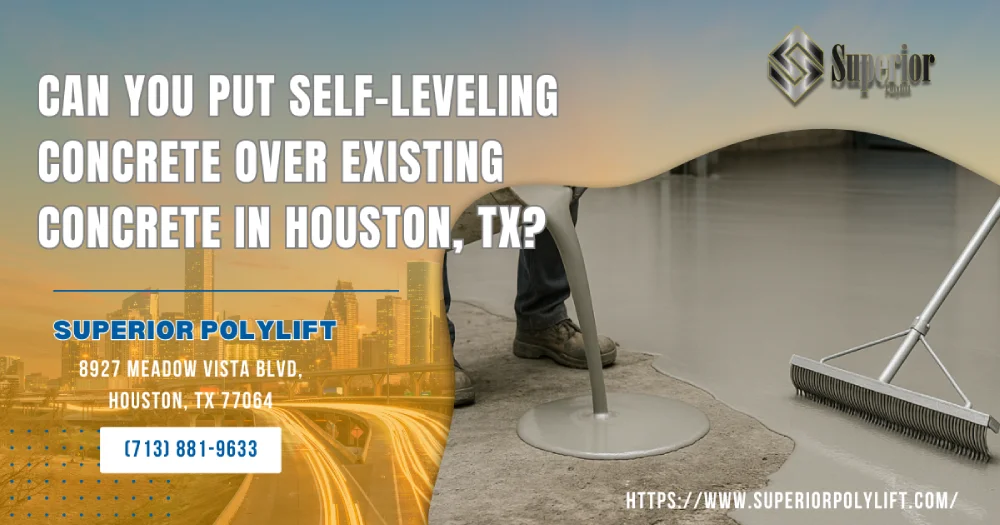
Wondering if you can refresh an uneven concrete floor without tearing it out? Yes, self-leveling concrete can be applied over existing concrete in Houston, TX, provided the slab is structurally sound and properly prepared. The existing concrete surface must be cleaned, profiled, and primed so the new level concrete bonds securely. When you pour self-leveling concrete correctly—following the manufacturer’s instructions and industry standards—you gain a smooth and stable layer that supports heavy foot traffic or machinery within days.
Before committing to demolition, you might wonder what benefits self-leveling concrete actually delivers. Understanding self-leveling concrete and its advantages helps you decide if the process aligns with your facility’s performance goals, downtime tolerance, and budget constraints—especially under Houston’s demanding environment.
| Overlay Thickness | Coverage Rate (per 50-lb bag) | Typical Compressive Strength | Recommended Uses |
| 1/4 in. (6 mm) | 23–25 sq ft | 4,000 psi | Cosmetic smoothing, light traffic areas |
| 1/2 in. (13 mm) | 12–14 sq ft | 5,000 psi | Production aisles, warehouse corridors |
| 1 in. (25 mm) | 6–7 sq ft | 6,500 psi | Forklift lanes, heavy-duty storage zones |
A Portland-cement or calcium-aluminate base is blended with polymers that promote flow. Mixed with water, the product is designed to flow and settle under its own weight, filling low spots and eliminating imperfections without extensive troweling. Rapid setting times bring the concrete floor back to service quickly—often ready for foot traffic in 4–6 hours, depending on the product.
Houston’s high humidity and temperature swings can crack traditional concrete mix toppings. Polymer-modified self-leveling concretes flex slightly with thermal movement, resist moisture penetration, and cure fast—helping industrial schedules stay on track. Superior PolyLift™ uses state-of-the-art pumps that maintain mix consistency, ensuring a level surface every time.
Self-leveling concrete won’t fix structural damage. Large cracks, moving joints, or differential settlement need concrete repair methods such as polyurethane foam injection, mudjacking, or replacement with new concrete. Always verify compatibility with coatings, polished concrete finishes, or epoxy underlayment systems planned for the new surface.
Preparation determines whether your overlay bonds or breaks apart. The following step-by-step guide outlines the tasks you—or your chosen leveling services contractor—must perform to achieve proper adhesion of the self-leveling material.
With the slab clean, dry, and primed, attention shifts to mixing, placing, and curing the self-leveler. Each stage has tight tolerances.
Even high-quality materials can fail if shortcuts are taken. Avoid these common pitfalls:
Spotting signs of serious substrate movement early helps you choose the right method—whether self-leveling, polyurethane foam lifting, or full-depth replacement.
Self-leveling work looks simple but requires experienced crews, specialized pumps, and tight logistics. Superior PolyLift™ offers Houston concrete leveling solutions that deliver smooth and stable surfaces across industrial properties.
Self-leveling concrete over existing concrete is an efficient, cost-effective way to level a concrete floor and create a new surface ready for industrial use. By following meticulous surface preparation, moisture control, and curing protocols, you ensure proper adhesion and long-term performance—even under Houston, TX, conditions. Need to level uneven floors or address an uneven concrete slab? Contact Superior PolyLift™ for state-of-the-art leveling services that minimize downtime and maximize durability.

Explore how our expertise can benefit your project. Reach out to our team for a consultation and discover the best solutions for your needs.
Copyright © All rights reserved. 2024 • Terms of Use and Privacy Policy • Internet Marketing by Authority Solutions®